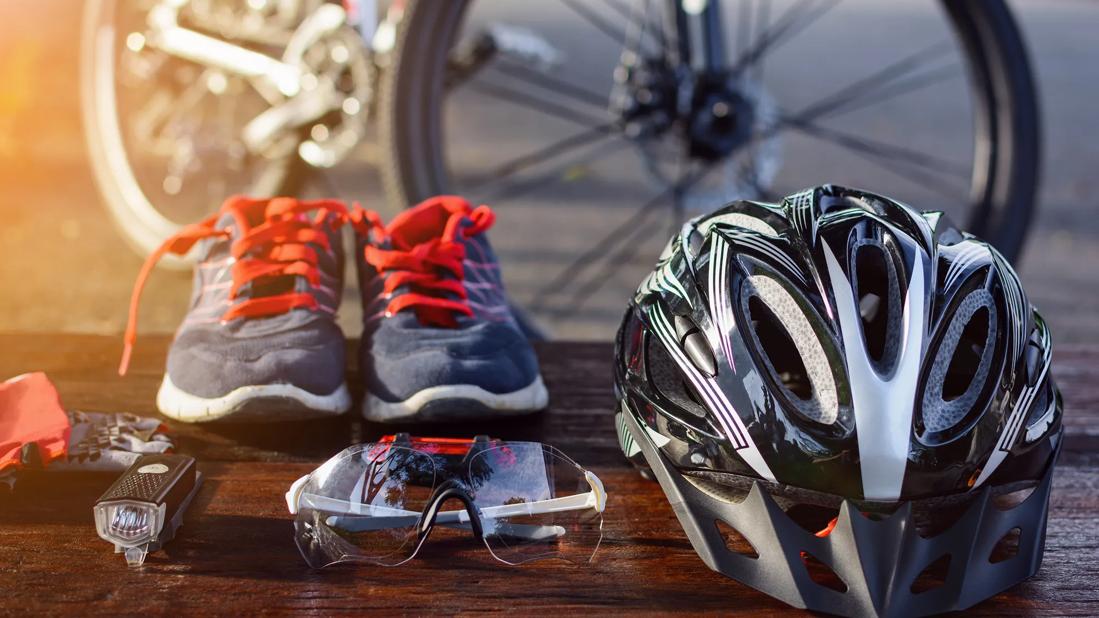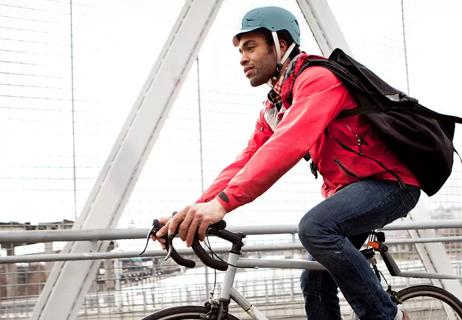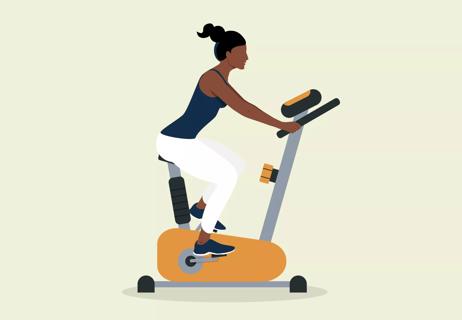Whether you’re cycling consistently or occasionally, it’s important to have safety essentials like a helmet, shirts with sleeves, eye protection and more

Riding a bike can help boost your health, offer independence and be an all-around fun activity. But whether you’re an avid cyclist or just taking your bicycle out for a spin occasionally, it’s important to equip yourself with the right gear.
Advertisement
Cleveland Clinic is a non-profit academic medical center. Advertising on our site helps support our mission. We do not endorse non-Cleveland Clinic products or services. Policy
So, what do you need before hitting the road?
Orthopaedic surgeon and sports medicine specialist Jessica Tomazic, MD, offers a list of must-haves to help you suit up for safety and comfort from head to toe.
Cycling accessories can reduce your risk of injury and make you more confident on the road. From proper clothing to emergency tools, here are some things to grab before you hit the pedal.
Head injuries are no joke, and they’re more common than you might think. The U.S. Centers for Disease Control and Prevention (CDC) found that nearly 597,000 bicycle-related traumatic brain injuries were treated in emergency rooms between 2009 and 2018.
That’s why a helmet is the most important piece of gear for any cyclist. Get a bicycle helmet that fits well and replace it regularly — about every five years. (Replace it right away if you experience a crash.)
There’s a reason all those Olympic riders are known for their neon hues. Wearing bright colors when biking helps drivers, pedestrians and other cyclists better see you on the road.
Also, opt for a shirt that has sleeves. Not only will this protect you against sunburn, but that extra vibrant fabric on your shoulders will help you stand out as well.
Advertisement
When it comes to proper bottoms for cycling, tight and short is best (at the same time, if possible!). This is because long, loose pants can get stuck in your bike’s wheel or chain and cause an accident. But if you’re recovering from saddle sores, it’s a good idea to take a break from cycling until you’re healed up.
When you’re on your bike, you’re open to all the elements — including the sun’s rays. And you don’t want to be blinded when you’re on a busy road or path. Glasses or goggles that wrap around your face are best, but even an inexpensive pair of sunglasses will keep bugs and debris out of your eyes. You can find clear glasses that are made specifically for riding at night or in inclement weather, too.
A good pair of cycling gloves can prevent injuries during a crash. They make riding more comfortable and cushion the nerves in your wrists that can compress over time (reducing the risk of carpal tunnel issues). Look for gloves made of breathable mesh or polyester.
With any kind of exercise, what you wear on your feet is crucial. For cycling, a pair of sneakers with stiffer soles will improve pedaling efficiency and reduce the risk of foot pain. You should also ensure they’re snug but not too tight. Also, look for shoes with breathable materials.
When it comes to staying steady on the bike, clipless pedals are an option (but this will come down to preference). These allow better ankle rotation, which can reduce your risk of joint injury. If you’re a frequent rider, this can be a good option for those longer trips. Keep in mind, this will require special cycling shoes that can attach to the pedals.
“Using clipless pedals does have a learning curve,” points out Dr. Tomazic. “Be sure to practice using them before you get on the road.”
Again, visibility is key when cycling. Having reflectors in the front, rear and side of your bicycle will improve your visibility from dawn until dusk. One low-cost way to do this is to purchase reflective duct tape and stick it prominently on your back and on the back and sides of your bike.
“I recommend a red, bright taillight,” advises Dr. Tomazic. “A flashing red light is a best practice to use even during daylight hours.”
Note: The main purpose of these reflectors is for others on the road to see you, not for you to see them.
When you’re focused on cycling, it’s not a good idea to keep too much on your back or shoulder. You want to stay balanced, not weigh yourself down. That’s why many cyclists put all of their necessities in a handy saddlebag on the back of their bike. It’s also good for keeping any tools or backup equipment you may need for your bike.
Advertisement
Think of a flat repair kit as your bike’s backup plan. Especially if you’re going on a longer ride, it’s good to have some tools in your saddlebag for fixing an unforeseen flat tire.
This includes items like:
Staying hydrated while cycling is an absolute must. That’s why you want to have an easily accessible water bottle. Make sure you have your water bottle placed in a sturdy cage connected to your bike frame to hold it securely while you’re riding.
Choose a sunscreen that’s water-resistant with an SPF of at least 50 and reapply liberally every hour. Don’t forget to cover the back of your neck and your ears. If you burn easily, zinc oxide is best.
If you’re going to ride frequently in the evening, a lighting system is necessary. Only a few on the market are adequate for night biking, Dr. Tomazic points out.
“Only the brightest systems are adequate,” she says. “Any bike lighting system should have front and rear lights, a large battery capacity and a large number of lumens.” (A good gauge is 800 lumens or higher, especially if you’re riding on darker roads.)
If you’re riding at night, reflective clothing will be your best friend. This clothing has reflective elements woven into the fabric, helping to light you up when headlights shine on you in the evening or early morning hours.
Advertisement
Cycling is a great way to keep you active and healthy — and get you from point A to point B! Just be sure to stay safe with the necessary gear. Items like a helmet, flat tire kit and reflectors are essential for every cyclist. Happy riding!
Advertisement
Learn more about our editorial process.
Advertisement

Make sure their bike is the right size, find a helmet that fits properly and teach them the rules of the road

Adjust your bike seat, wear breathable clothing and don’t pop or pick!

Fit, duration and positioning are more important than you might think

Studies show the protective gear can significantly reduce head and brain injuries

How to make the most out of cycling

Expert advice on helping your muscles repair and replenish

You can improve your athletic performance over time by breaking up your workout regimen into focused cycles

Start training with full-body workouts at least six to eight weeks before you hit the slopes

Start having sex about 72 hours before ovulation, then at least every other day during your fertile window

Attachment theory suggests that your earliest relationships shape connections throughout your life

It isn’t a recognized mental health disorder, but research shows that problematic social media use can negatively affect your mental health, self-esteem and sleep